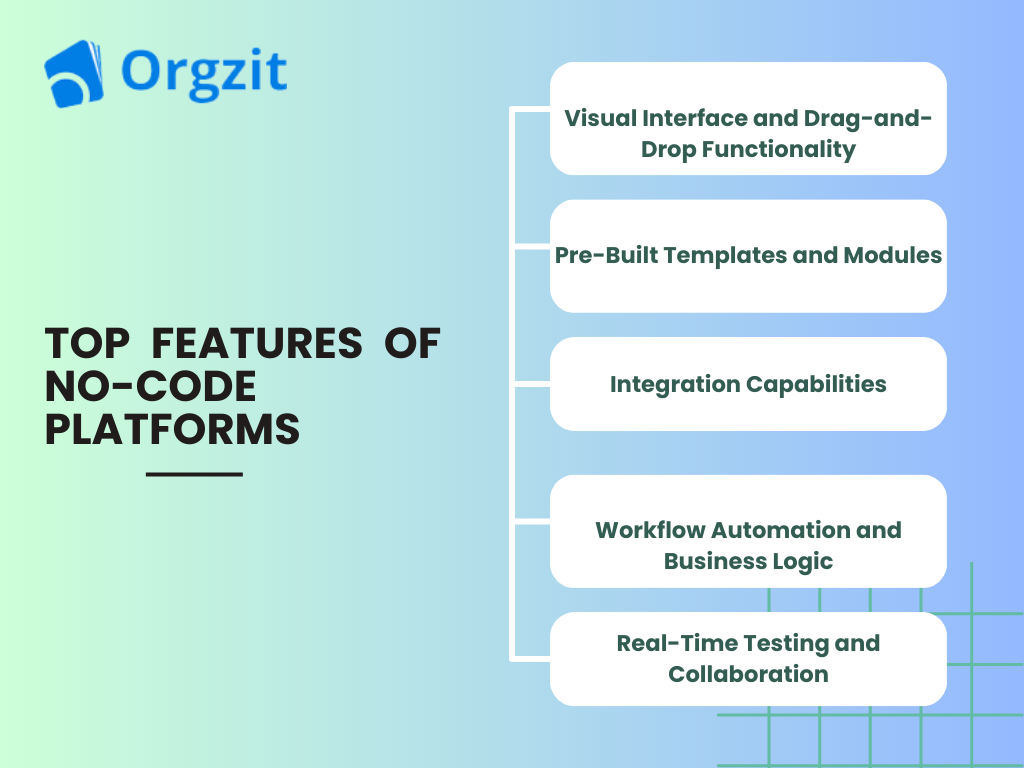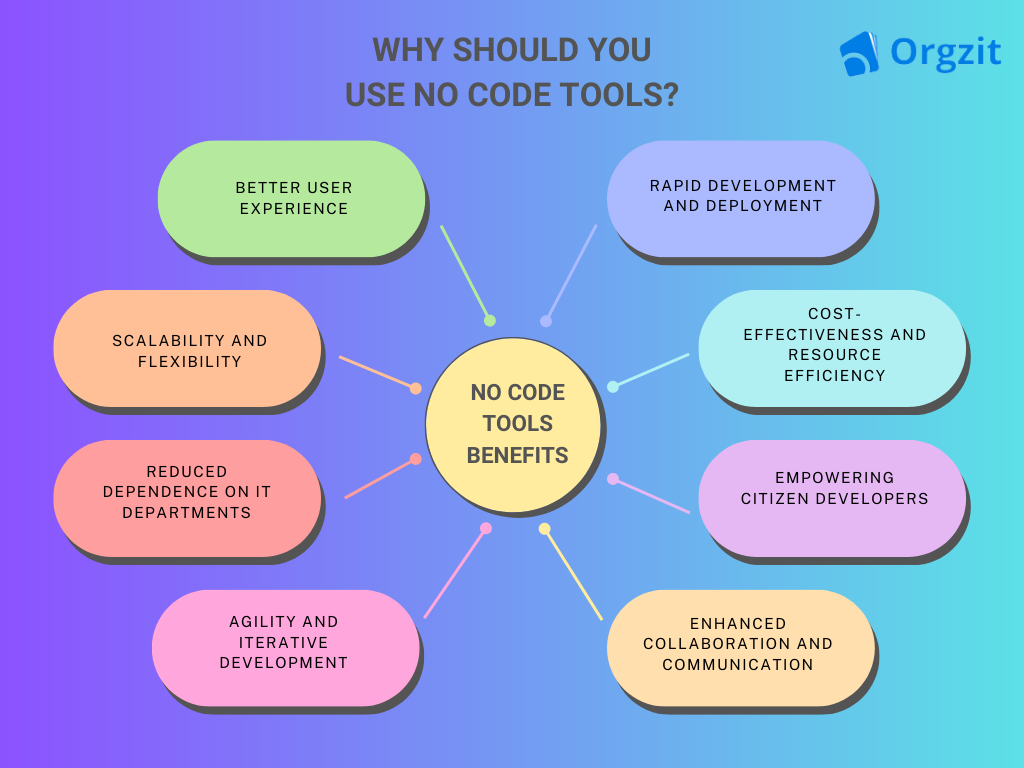Benefits of Using No Code Tools For Building Business Applications
Discover the game-changing world of no-code technology! If you’re a business seeking innovative ways to boost productivity and efficiency without the complexities of coding, you’re in for a treat.
Say goodbye to the traditional struggles of application development, as no-code platforms empower you to create fully functional business applications effortlessly.
This blog explores the countless benefits of utilizing no-code tools for building business applications.
From streamlining operations to catering to unique needs, these platforms unlock new possibilities for businesses like yours. Embrace the future of application development where creativity knows no bounds and coding barriers are a thing of the past.
Get ready to revolutionize your business with the power of no-code technology!
What Is Business Application Development?
Business application development refers to the process of creating software applications specifically designed to address the needs and challenges of businesses. These applications are developed to streamline operations, enhance productivity, and improve overall efficiency in various aspects of business operations.
Business application development encompasses a wide range of software solutions, including enterprise resource planning (ERP) systems, customer relationship management (CRM) software, human resources management systems (HRMS), inventory management systems, and more.
Key characteristics of business application development include:
1. Customization: Business applications are often tailor-made to suit the unique requirements of a particular organization. Developers work closely with businesses to understand their processes, workflows, and pain points, creating applications that align with their needs.
2. Integration: Business applications are designed to integrate seamlessly with existing systems and databases within an organization. Integration capabilities allow these applications to access and exchange data with other software, enabling a cohesive and efficient flow of information across different departments.
3. Automation: Automation is a key feature of many business applications. By automating repetitive and manual tasks, such as data entry, report generation, and workflow approvals, businesses can save time, reduce errors, and free up their employees to focus on more strategic tasks.
4. Scalability: As businesses grow and evolve, their software needs must also scale accordingly. Business applications are designed with scalability in mind, allowing them to handle increased data volumes and user demands without compromising performance.
5. Security: Security is paramount in business application development. These applications often handle sensitive data and play critical roles in day-to-day business operations. Robust security measures, such as data encryption, user authentication, and access controls, are implemented to protect against unauthorized access and data breaches.
6. User-Friendly Interface: Business applications are built with user experience in mind. A user-friendly interface ensures employees can quickly adapt to the new software, leading to higher adoption rates and improved productivity.
7. Analytics and Reporting: Business applications often incorporate analytics and reporting capabilities. These features enable businesses to gain valuable insights from their data, make informed decisions, and identify areas for improvement.
8. Mobile Support: With the increasing reliance on mobile devices, many business applications offer mobile support. Mobile-friendly versions or dedicated mobile apps allow employees to access critical information and perform tasks while on the go, enhancing flexibility and productivity.
Benefits of Business Application Development:
The development and implementation of business applications offer several significant benefits to organizations:
1. Streamlined Processes: Business applications streamline workflows and processes, eliminating manual inefficiencies and reducing the likelihood of errors. This results in faster and more accurate operations, enhancing overall productivity.
2. Improved Data Management: Business applications centralize data and ensure data integrity through proper validation and security measures. This centralized approach enables better data management, easier data analysis, and more informed decision-making.
3. Enhanced Customer Engagement: CRM and customer-focused applications enable businesses to understand their customers’ needs and preferences better. This leads to improved customer engagement, personalized experiences, and increased customer satisfaction and loyalty.
4. Cost Efficiency: While the initial investment in developing business applications can be substantial, the long-term cost savings are significant. Automation, improved efficiency, and reduced manual efforts lead to cost savings over time.
5. Competitive Advantage: Customized business applications provide a competitive edge by offering unique features and capabilities tailored to the organization’s specific needs. Such applications enhance efficiency, productivity, and customer service, setting businesses apart from competitors.
Top Features of No-Code Platforms


Now, let’s explore the top features of no-code platforms that make them valuable tools for individuals and businesses:
1. Visual Interface and Drag-and-Drop Functionality
One of the key features of no-code platforms is their visual interface and drag-and-drop functionality. Instead of writing code, users can build applications by visually designing the user interface and workflow using pre-built components and widgets.
This approach eliminates the need for traditional coding languages, making it accessible to a broader audience, including non-technical users.
2. Pre-Built Templates and Modules
No-code platforms often come with a library of pre-built templates and modules that users can leverage to jumpstart their app development process. These templates are starting points for various applications like databases, dashboards, e-commerce sites, etc.
Users can customize these templates to suit their requirements, saving time and effort in app creation.
3. Integration Capabilities
Integration capabilities are essential for no-code platforms to connect with external services and data sources. These platforms often offer pre-built connectors and APIs that allow users to integrate with popular third-party services, cloud platforms, and databases.
This enables seamless data exchange and functionality enrichment, making the created applications more powerful and versatile.
4. Workflow Automation and Business Logic
No-code platforms empower users to automate workflows and define business logic without writing traditional code. With the help of intuitive visual editors, users can create complex automation sequences and conditional logic to respond to specific events and triggers.
This feature enables the development of process-driven applications that enhance efficiency and reduce manual tasks.
5. Real-Time Testing and Collaboration
No-code platforms typically provide real-time testing capabilities, allowing users to preview their applications and test their functionality as they build them. This iterative approach enables quick feedback and allows for rapid improvements.
Additionally, no-code platforms often support collaborative features, allowing multiple team members to work on the same project simultaneously, enhancing teamwork and productivity.
What are No-Code Tools?
No-code tools refer to software development platforms that enable users to create applications or software solutions without traditional coding skills. These tools offer a visual, user-friendly interface that allows individuals, often called “citizen developers,” to design, develop, and deploy applications by utilizing pre-built elements, drag-and-drop functionalities, and simple configurations.
Unlike traditional software development that requires proficiency in programming languages such as Python, Java, or C++, no-code platforms eliminate the complexities of coding, making application development accessible to a wider audience. With no-code tools, users can focus on their applications’ logical flow and design rather than getting bogged down in intricate coding syntax and algorithms.
No-code tools have gained popularity due to their ability to accelerate development, reduce costs, and democratize software creation. These platforms cater to entrepreneurs, small business owners, and professionals from non-technical backgrounds, enabling them to bring their ideas to life without hiring dedicated developers or investing extensive time in learning programming languages.
Top 7 Benefits of Using No Code Tools To Build Business Applications


No-code technology has revolutionized how businesses develop and deploy applications in recent years. No-code platforms empower users without extensive programming knowledge to create sophisticated and functional business applications.
As companies seek to streamline processes and stay ahead in a competitive landscape, no-code development platforms have emerged as valuable tools. This article will explore the top seven benefits of leveraging no-code tools to build business applications, highlighting how they enhance productivity, accelerate development, and foster innovation.
Rapid Development and Deployment
One of the primary advantages of no-code platforms is their ability to facilitate rapid application development and deployment. Traditional software development typically involves lengthy coding processes, testing, and debugging.
Conversely, no-code development tools employ a visual interface that allows users to drag and drop elements, set up data connections, and configure functionalities without writing code manually. It enables business stakeholders, even those without technical backgrounds, to actively participate in the development process.
As a result, applications can be built and deployed in a fraction of the time it would take with traditional coding methods.
Cost-Effectiveness and Resource Efficiency
No-code technology significantly reduces the costs associated with developing business applications. Companies can allocate their resources more efficiently by eliminating the need for dedicated teams of developers.
With no-code platforms, employees from various departments can collaborate on application development, leveraging their domain expertise without relying solely on IT specialists. The speed at which applications can be built and deployed means businesses can save time and money.
Empowering Citizen Developers
No-code development tools democratize application development, enabling non-technical employees (citizen developers) to contribute actively to creating business applications. Armed with no-code platforms, citizen developers can design, customize, and iterate on applications without relying on IT departments.
It not only streamlines the development process but also fosters a culture of innovation within the organization. No-code technology cultivates a more agile and adaptable workforce by empowering employees to be directly involved in building applications.
Enhanced Collaboration and Communication
No-code platforms facilitate seamless collaboration and communication between different teams within an organization. Due to technical jargon and complex workflows, traditional software development often involves communication barriers between business stakeholders and developers. No-code technology eliminates these hurdles, allowing technical and non-technical teams to collaborate in a shared environment.
This transparency enhances mutual understanding, reduces miscommunication, and fosters a more cohesive development process. Moreover, real-time feedback and updates within the platform ensure that all stakeholders are on the same page during the development lifecycle.
Agility and Iterative Development
Agility is crucial for businesses to stay competitive in a fast-paced market. No-code development platforms enable iterative development, allowing applications to be continuously improved and adapted to changing requirements.
Updates and modifications can be implemented quickly without the need for extensive coding or complicated release processes. This agility ensures that applications remain relevant, efficient, and aligned with evolving business needs.
Furthermore, the ability to prototype and experiment rapidly allows businesses to test new ideas without investing significant time and resources upfront.
Reduced Dependence on IT Departments
Traditional software development often requires constant engagement with IT departments to build, update, and maintain applications. With no-code platforms, business users can largely become self-sufficient in developing applications without relying heavily on IT teams.
This reduced dependence on IT empowers the IT department to focus on more complex tasks, such as infrastructure management, data security, and advanced system integration.
It also alleviates the burden of application development from IT professionals, allowing them to prioritize strategic initiatives and overall IT governance.
Scalability and Flexibility
No-code technology is highly scalable and flexible, accommodating the changing needs of businesses as they grow. No-code development tools can handle both scenarios, whether a company requires a small-scale internal application or a large-scale customer-facing platform.
The ability to scale applications effortlessly ensures that businesses can expand their offerings without being held back by technical limitations. Additionally, no-code platforms are flexible enough to integrate with existing systems, databases, and third-party services, making them ideal for businesses with diverse technological requirements.
The Bottom Line
Adopting no-code tools for building business applications has ushered in a new era of innovation and efficiency in the corporate world. These platforms offer a range of compelling benefits that have transformed the way organizations approach application development.
No-code technology’s rapid development and deployment capabilities empower businesses to respond swiftly to market demands and stay ahead of the competition.
Moreover, the cost-effectiveness and resource efficiency achieved through these platforms allows for optimal allocation of resources and streamlined workflows.
The empowerment of citizen developers has emerged as a pivotal advantage, fostering a culture of innovation and collaboration within organizations. With reduced dependence on IT departments, businesses can unleash the full potential of their IT teams for strategic initiatives and future-proofing their systems.
The agility and flexibility offered by no-code platforms enable iterative development, ensuring that applications can continually evolve to meet changing requirements.
As we look ahead, the prominence of no-code development tools is set to grow even further. One such powerful tool, Orgzit, stands out as an all-in-one Sales CRM for Manufacturers’ Reps and Distributors. With Orgzit’s centralized dashboard, businesses can seamlessly align sales, estimation, finance, accounts, and services teams.
Say goodbye to scattered spreadsheets, as Orgzit enables efficient management of opportunities, quotes, invoices, and orders within one simple and user-friendly application.
The bid dashboard, quick quote creation, automated email functionalities, and follow-up reminders add further convenience and productivity to your sales process. Embrace the power of Orgzit and elevate your business operations to new heights.
Schedule a demo today to explore more.









